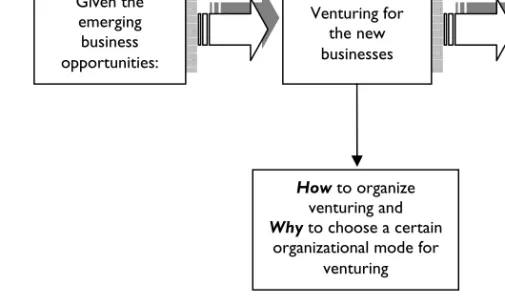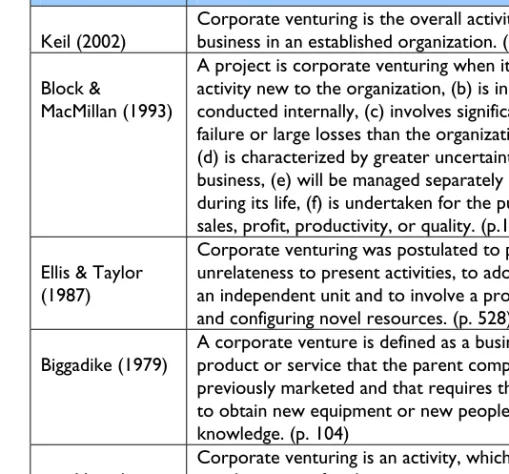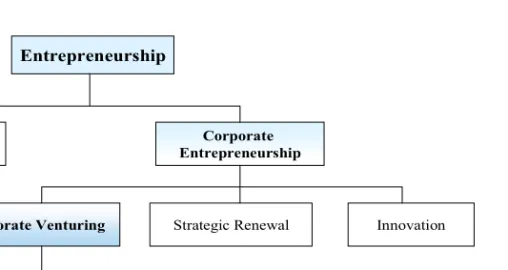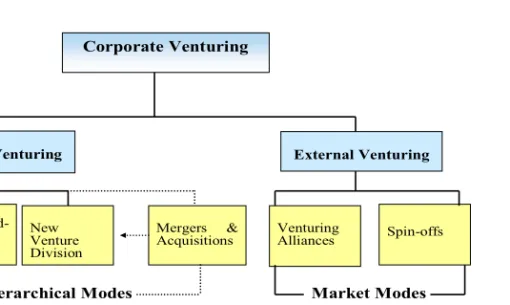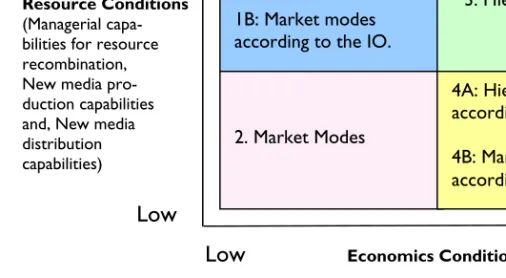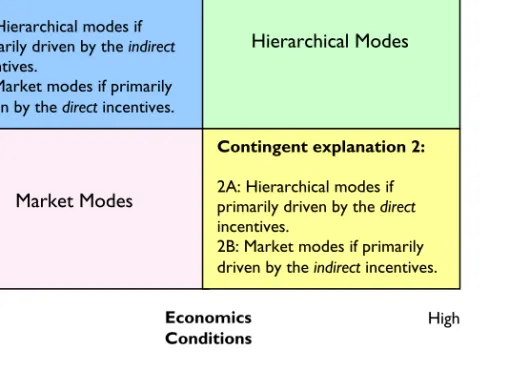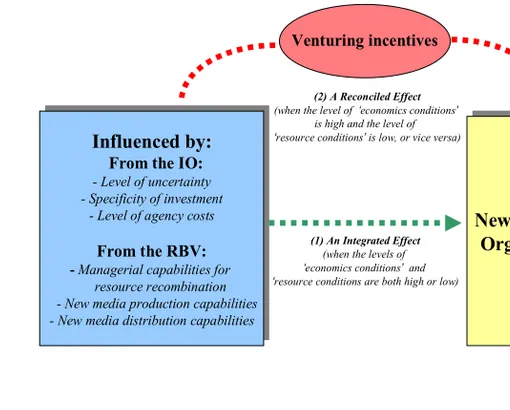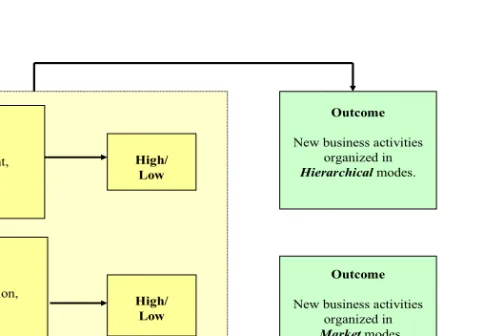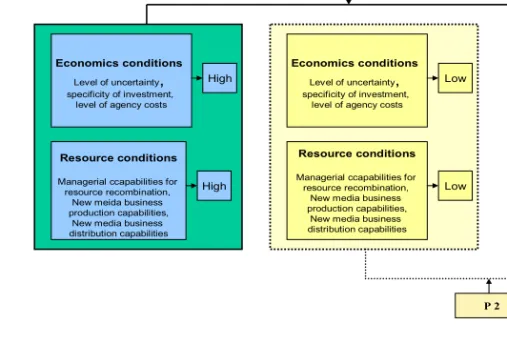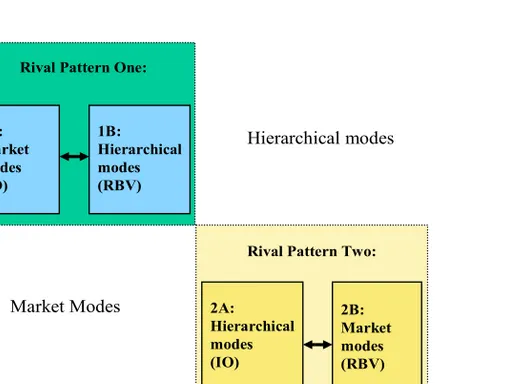JIBS Disser
tation Series No
. 044
MIN HANG
Media Business Venturing
A Study on the Choice of Organizational Mode
M ed ia B us in es s V en tu rin g
MIN HANG
Media Business Venturing
A Study on the Choice of Organizational Mode
IN H
A
N
G
In a dynamic environment characterized by constant technological advancement, new business opportunities appear in a variety of forms in the media industries. While venturing for these emerging opportunities, media firms are confronted with challenges such how to organize venturing and why to choose a certain organizational mode for the development of new business.
Both the IO and RBV give valuable implications to the choice of venturing organizational mode. However, in some circumstances, explanations derived from these two theories may conflict with each other rather than harmonizing. Therefore, how to understand the different interpretations given by the two theories and what is the relationship between the traditional economics theories and the more recent resource-based theories in the specific context of new media business venturing are the central issues in this research.
To answer such questions, a case study strategy was adopted, and eight new media venturing cases were investigated within six media companies. Findings from empirical study indicated that certain ‘economics & resource conditions’ associated with the venturing initiatives influenced the new media venturing organizational modes, and the dynamics of venturing organizational modes were also affected by changes in venturing incentives. In addition, a number of macro-environmental, media industrial, market and firm specific factors had particular impacts on new media development, which constitute industry-specific characteristics of media corporate venturing.
JIBS Dissertation Series
JIBS Disser
tation Series No
. 044
MIN HANG
Media Business Venturing
A Study on the Choice of Organizational Mode
M ed ia B us in es s V en tu rin g
MIN HANG
Media Business Venturing
A Study on the Choice of Organizational Mode
IN H
A
N
G
In a dynamic environment characterized by constant technological advancement, new business opportunities appear in a variety of forms in the media industries. While venturing for these emerging opportunities, media firms are confronted with challenges such how to organize venturing and why to choose a certain organizational mode for the development of new business.
Both the IO and RBV give valuable implications to the choice of venturing organizational mode. However, in some circumstances, explanations derived from these two theories may conflict with each other rather than harmonizing. Therefore, how to understand the different interpretations given by the two theories and what is the relationship between the traditional economics theories and the more recent resource-based theories in the specific context of new media business venturing are the central issues in this research.
To answer such questions, a case study strategy was adopted, and eight new media venturing cases were investigated within six media companies. Findings from empirical study indicated that certain ‘economics & resource conditions’ associated with the venturing initiatives influenced the new media venturing organizational modes, and the dynamics of venturing organizational modes were also affected by changes in venturing incentives. In addition, a number of macro-environmental, media industrial, market and firm specific factors had particular impacts on new media development, which constitute industry-specific characteristics of media corporate venturing.
JIBS Dissertation
MIN HANG
Media Business Venturing
Jönköping International Business School P.O. Box 1026 SE-551 11 Jönköping Tel.: +46 36 10 10 00 E-mail: info@jibs.hj.se www.jibs.se
Media Business Venturing: A Study on the Choice of Organizational Mode
JIBS Dissertation Series No. 044
Financed by and written within the Media Management and Transformation Centre at Jönköping International Business School
© 2007 Min Hang and Jönköping International Business School
ISSN 1403-0470 ISBN 91-89164-81-4
谨以此书献给我的父母、应平及我们的小瑞瑞
Acknowledgement
As a Chinese, I believe in “Yuan”, which connotes destiny and serendipity. “Yuan” took me across the ocean six years ago and opened a new window of opportunity for me in Sweden to pursue my doctoral studies in Media Management in Jönköping. In pursuing the doctoral degree, I have received tremendous support form many people. It is with great pleasure that I now have the chance to express my sincere gratitude to all of them.
My greatest appreciation goes to my main supervisor, Prof. Robert Picard, who guided me with enormous expertise and inspired me with patience. Robert gave me great impetus to associate with media studies, and he continuously gave me courage and confidence to overcome hard times along the way. His influence will leave a lasting mark on me, and I respect him as a lifetime tutor.
I am also very grateful to my second supervisor, Associate Professor Mike Danilovic who helped me with my teaching obligations when I started. After he was invited to be a supervisor, Mike generously spent time with me, stimulating suggestions, discussing key issues and inspiring me to find solutions. Prof. Rolf Rundin also kindly shared his time and counsel with me for my research, lending me support and giving me insight into a variety of important issues. Rolf encouraged me to challenge and to question, turning me into a much mature researcher.
Prof. Karl-Erik Gustafsson has been always available to discuss with me my research and to share his experiences and knowledge. He is a true gentleman, who conveys his gracious values to young researchers with his attitude towards work and life.
My debt of gratitude can hardly be repaid to my good friend Cinzia Dal Zotto, who has given me tremendous care and support. We spent many after-work nights and weekends together. For the dissertation work, Cinzia helped me with the research proposal, provided substantive suggestions to build my analysis, improved my presentation and clarified my arguments.
Also, I want to extend my gratitude to my doctoral student colleagues: Aldo Van Weezel for our never-ending discussions and arguments, who I now miss since he moved back to Chile with his family; Maria Norbäck and Mart Ots who enriched me with their comments and encouragement since the start; Leon Barkho, Edward Humphreys, Elena Raviola and Anette Johansson who were often helpful giving me their opinions and adding more insights to my work.
academic challenges and diversions provided by my student colleagues.
I owe a great amount of thanks to the faculty and staff of EMM who assisted and encouraged me in various ways during my course studies and dissertation work. Special thanks to Prof. Johan Wiklund for his valuable comments on the early version of the dissertation; to Prof. Tomas Müllern for help me with a better understanding on methodology; and to Prof. Helén Anderson and Associate Professor Ethel Brundin for inspiring me with new knowledge. The effort exerted by many people and their goodwill have made the completion of this dissertation possible. Associate Professor Lucy Küng kindly helped me to review and to strengthen the theoretical part of the dissertation. Associate professor Leona Achtenhagen gave me valuable comments at different stages and she provided significant suggestions on how to improve the dissertation against possible critical remarks.
I would also like to give my sincere appreciation to Prof. Hans von Kranenburg, who acted as the discussant for my final seminar. I am grateful for his timely and generous help and constructive inputs to improve my work.
During my stay in the CITI, Columbia University last year, I received warm welcome and valuable information. I am very grateful to Professor Eli Noam and his staff, for their hospitality and for generously sharing with me their knowledge into cutting-edge media management issues. I am also thankful for their help with access to major media companies for interviews. In addition, I wish to express my gratitude to Prof. Everette Dennis, Prof. John Pavlik and Prof. John Carey for their enlightening conversations during my visit to the U.S. Furthermore, I would like to thank all the informants in my empirical study for their valuable input.
My research and study would not have been possible to carry out without the generous support from the Hamrin family. I gratefully acknowledge their kind support not only financially, but also emotionally. Actually, Christina and Stig’s Crayfish parties have been one of the most unforgettable parts of the lovely memories of Jönköping.
I owe a great deal of special thanks to Barbara Eklöf. As a responsible administrator and a most truthful friend, Barbara has been always a steady source of encouragement during the dissertation process. Her sincere concern on a daily basis is an irreplaceable value. All dissertation writers suffer highs and lows; she made the highs higher and the lows bearable.
interview transcripts and different versions of the manuscript. Meanwhile, I would express my gratitude to Leon Barkho for his professional help with my language editing. Of course, thanks are extended to Susanne Hansson who was the first person I spoke to from Jönköping. On a sunny afternoon four years ago, she opened a new window when I got an unexpected and exciting call from her; and since then, her kindness and thoughtful care have always been with me. Finally, I would like to give my appreciation to my parents. They descend from a great generation, who have worked extremely hard to provide a better future for their children. Every smile on their faces is there for the sake of their children’s happiness. Thus, I feel privileged to be the never-ending source of their happiness. I also thank my husband Yingping, for all his understanding and for loving me no matter how geographically distant we are. My most tender appreciation goes to my darling daughter Ruirui, she has brought new meaning to my life, and since then, for another generation, love lasts and extends. I dedicate this dissertation to my parents, Yingping and Ruirui, for their love, endless support and encouragement.
杭 敏 Min Hang Jönköping 2007
Abstract
In a dynamic environment characterized by constant technological advancement, new business opportunities appear in a variety of forms in the media industries. Adaptation to the changing environment and proactive transformation are crucial to media business success. Media firms need to develop strategic tools that enable new business creation and facilitate capturing opportunities arising from the emerging fields. These new business creation activities are different from the incremental business developments that are usually conducted inside the existing product-market frameworks; they are radical changes gearing towards developing new product-market frameworks. The overall activities of building new business in an established organization are referred to as corporate venturing.
Though corporate venturing has received increasing attention in recent years, much less research has been made on the aspects of venturing organizational modes. Nevertheless, in the media industries, while venturing for the emerging opportunities, many firms are confronted with organizational challenges such as:
should the new media business be integrated into the firm’s existing operation or should it be independently operated, standing on its own legs, in order to become a viable business?
In seeking answers for such questions, both the Industrial Organizational Theories (IO) and Resource-based View (RBV) can provide tools for analysis. The IO—the traditional industrial economics theories—seek to give explanation from an economics perspective. They tend to explain new business venturing as economic activities that aim to minimize costs. The RBV—a more recent internal resource/competence-based theory—seeks to give explanation to the new business venturing from the resource perspective, by focusing on the resource/competence development of the new business.
Both the IO and RBV give valuable implications to the choice of venturing organizational mode for new business creation. However, in some circumstances, explanations derived from these two theories may conflict with each other rather than harmonizing. How to understand the different interpretations given by the two theories and what is the relationship between the traditional economics theories and the more recent resource-based theories in the specific context of new media business venturing are the central issues in this dissertation.
explain the choice of organizational mode for venturing as each provides insights into different perspectives; thus, an integration of the IO and RBV is needed in an effort to understand the complex phenomena of business venturing. However, depending on whether the venturing incentives are primarily cost/profit-driven or resource/competence development-oriented, the IO and RBV may have different predicting powers. Therefore, a reconciliation of the two theories is required where conflicts occur.
Propositions were developed from these contentions, and a case study research strategy was applied. Eight new media venturing cases were investigated within six media companies. Findings from the empirical study indicated that certain ‘economics & resource conditions’ associated with the venturing initiatives influenced the choice of new media venturing organizational mode, and the dynamics of organizational mode were also affected by changes in venturing incentives. In addition, the empirical studies found out that several macro-environmental, media industrial, market and firm specific factors had particular impacts on the new media venturing, which constitute industry-specific characteristics of the media corporate venturing.
There are also implications for media management research derived from this study. The nature of media management is multidisciplinary, so a multiplicity of theories may better serve the needs of future media management inquiries. To develop integrated and reconciled frameworks incorporating theories from different fields, in-depth reviews of theories and understandings of the appropriate circumstances that may apply these theories are required.
List of Contents
Acknowledgement ... v
Abstract...ix
List of Contents...xi
Lists of figures and tables ...xvii
PART I. INTRODUCTION ...1
1. Media Business Venturing: Challenges and Research Issues ...3
1.1
Venturing in the corporate context...3
1.2
Purpose of study...5
1.3
Research questions ...6
1.4
The media industries as context for research ...7
1.5
Expected contributions ...8
1.6
Overview of the dissertation...9
PART II. RESEARCH CONTEXT ... 11
2. The Media Industries and New Media Business Opportunities ... 13
2.1
Media and the media industries... 13
2.2
Changes in the media industries ... 14
2.3
Rationales for new media business creation ... 16
2.4
New media business opportunities ... 17
2.4.1 Internet media business opportunities ... 17
2.4.2 Webcasting business opportunities ... 18
2.4.3 Broadband TV business opportunities... 19
2.4.4 Online gaming business opportunities ... 20
2.4.5 Mobile media business opportunities... 21
2.4.6 Venture capital opportunities... 23
2.5
Challenges from the new media business venturing... 23
PART III. THEORETICAL FRAMEWORK ... 25
3. Corporate Venturing and Choice of Organizational Mode ... 27
3.1.2 Entrepreneurial individuals ... 30
3.2
Defining corporate venturing ... 32
3.3
Incentives for corporate venturing... 37
3.4
Corporate venturing organizational modes ... 38
3.4.1 Studies conducted on corporate venturing
organizational modes ... 39
3.4.2 Studies comparing different venturing organizational
modes... 40
3.4.3 A typology of corporate venturing organizational
modes... 41
3.5
Theories applied in this research... 44
3.5.1 The economics perspective ... 45
3.5.2 The resource-based perspective... 47
3.5.3. Relations between the economics and resource
perspectives ... 49
3.5.4 Reconciling the economics and resource
perspectives ... 50
3.5.4.1 A current trend to reconcile the economics and
resource perspectives... 50
3.5.4.2 Research that reconciles the economics and
resource perspectives... 51
3.5.4.3 This researcher’s contention ... 52
3.6
Applying theories to the new media business
venturing ... 53
3.6.1 From the economics perspective ... 53
3.6.2 From the resource perspective... 56
3.6.3 Divergent directions and contingent explanations ... 58
PART IV. RESEARCH STRATEGY... 63
4. A Case Study Research Strategy ... 65
4.1
Some epistemological stances ... 65
4.2
The case study as a research strategy ... 66
4.3
Research techniques ... 67
4.3.1 The Logic model ... 68
4.3.2 Rival explanations ... 69
4.4
Selecting cases ... 72
4.5
Collecting data ... 78
4.6
Data analysis and presenting ... 80
4.7
Issues of validity and reliability ... 80
PART V. ANALYSIS OF CASES ... 83
5. Internet Business Venturing and Mobile Media Venturing in
News Corporation ... 87
5.1
News Corporation: Company information... 87
5.2
New business venturing in News Corporation... 90
5.3
Two cases: Internet Business Venturing and Mobile
Media Venturing ... 92
5.3.1 Case 1: Internet Business Venturing ... 92
5.3.1.1 The early start ... 92
5.3.1.2 Recent development ... 93
5.3.2 Case 2: Mobile Media Venturing ... 95
5.4
Analysis ... 96
5.4.1 Analysis of the Internet Business Venturing... 96
5.4.1.1 The ‘economics conditions’... 97
5.4.1.2 The ‘resource conditions’... 98
5.4.1.3 Incentives... 99
5.4.1.4 Factors influencing venturing organizational
modes ... 100
5.4.2 Analysis of the Mobile Media Venturing... 100
5.4.2.1 The ‘economics conditions’... 100
5.4.2.2 The ‘resource conditions’... 101
5.4.2.3 Incentives... 102
5.4.2.4 Factors influencing venturing organizational
modes ... 103
5.5
Summary... 103
5.5.1 Summary of the Internet Business Venturing case ... 103
5.5.2 Summary of the Mobile Business Venturing case... 106
6. Internet Business Venturing in the New York Times Company . 111
6.1
The New York Times Company: General
Information ... 111
6.2
New business venturing in the NYT... 114
6.4.1 The ‘economics conditions’ ... 117
6.4.2 The ‘resource conditions’... 118
6.4.3 Incentives... 119
6.4.4 Factors influencing venturing organizational modes .... 120
6.5
Summary... 120
7. FiOS TV Venturing and Online Gaming Business Venturing in
Verizon Communications... 125
7.1
Verizon: Company Information... 125
7.2
New Business Venturing in Verizon... 128
7.3
Two cases: FiOS TV Venturing and Online Gaming
Business Venturing... 129
7.3.1 Case 1: FiOS TV Venturing ... 129
7.3.2 Case 2: Online Gaming Business Venturing ... 130
7.4
Analysis ... 131
7.4.1 Analysis of the FiOS TV Venturing... 132
7.4.1.1 The ‘economics conditions’... 132
7.4.1.2 The ‘resource conditions’... 133
7.4.1.3 Incentives... 133
7.4.1.4 Factors influencing venturing organizational
modes ... 134
7.4.2 Analysis of the Online Gaming Business Venturing ... 134
7.4.2.1 The ‘economics conditions’... 134
7.4.2.2 The ‘resource conditions’... 135
7.4.2.3 Incentives... 135
7.4.2.4 Factors influencing venturing organizational
modes ... 136
7.5
Summary... 136
7.5.1 Summary of the FiOS TV venturing case ... 136
7.5.2 Summary of the Online Gaming Business Venturing
case ... 138
8. Mobile Distributing Consumer Media Venturing in YouTube... 141
8.1
YouTube: Company information ... 141
8.2
Case of the Mobile Distributing Consumer Media
Venturing... 143
8.3.3 Incentives... 146
8.3.4. Factors influencing venturing organizing modes... 146
8.4
Summary... 147
9. Webcasting Business Venturing in the China Telecom
Corporation ... 151
9.1
China Telecom: General information ... 151
9.2
New business venturing in the China Telecom... 152
9.3
Case of Webcasting Business Venturing ... 153
9.4
Analysis ... 153
9.4.1 The ‘economics conditions’ ... 154
9.4.2 The ‘resource conditions’... 155
9.4.3 Incentives... 155
9.4.4. Factors influencing venturing organizational modes... 156
9.5
Summary... 156
10. Greenhouse Venturing in the Reuters ... 161
10.1 Reuters: Company information ... 161
10.2 New business venturing in Reuters ... 163
10.3 Case of Reuters Greenhouse Venturing ... 164
10.4 Analysis... 166
10.4.1 The ‘economics conditions’ ... 166
10.4.2 The ‘resource conditions’ ... 167
10.4.3 Incentives ... 168
10.3.4 Factors influencing venturing organizational modes.. 168
10.5 Summary ... 168
PART VI. CONCLUSIONS AND MEDIA SPECIFIC
IMPLICATIONS... 173
11. Conclusions ... 175
11.1 Corporate venturing from the economics and resource
perspectives... 175
11.2 A case study strategy for venturing organizational
studies... 177
11.3 Findings from the empirical study ... 178
the choice of venturing organizational mode... 182
11.4 Conclusions ... 185
11.5 Theoretical contributions ... 187
11.6 Limitations of the study ... 189
12. Media Specific Implications... 191
12.1 Media managerial implications... 191
12.2 Media theoretical implications ... 193
12.3 Future research agenda ... 195
12.4 Further remarks ... 197
Appendix I. Case study protocols ... 199
Appendix II. Questionnaire... 200
References ... 203
Lists of figures and tables
LIST OF FIGURES
Figure 1. Research questions
Figure 2. Hierarchy of terminology in corporate entrepreneurship Figure 3. A typology of corporate venturing organizational modes
Figure 4. The operational relatedness of different venturing organizational modes
Figure 5. Organizational modes according to the ‘economics conditions’ Figure 6. Organizational modes according to the ‘resource conditions’ Figure 7. Divergent directions
Figure 8. Contingent explanations Figure 9. The theoretical model Figure 10. The logic model Figure 11. Propositions 1 and 2 Figure 12. Rival explanations Figure 13. Propositions 3,4,5 and 6
Figure 14. The replication approach to multiple-case study
Figure 15. Four categories associated with different ‘resource & economics conditions’
Figure 16. New media venturing cases selected for each category
Figure 17. Changes of venturing organizational modes for Internet Business Figure 18. Changes of venturing organizational modes for Mobile Media Business
Figure 19. Changes of venturing organizational modes for Internet Business Venturing in the NYTC
Figure 20. Venturing organizational modes for FiOS TV Business Figure 21. Venturing organizational modes for Online Gaming Business Figure 22. Venturing organizational modes for Mobile Distributing Consumer Media
Figure 23. Venturing organizational modes for Webcasting Business Figure 24. Changes of venturing organizational modes for Reuters Greenhouse
LIST OF TABLES
Table 1. Examples of some existing definitions of corporate venturing Table 2. Incentives for corporate venturing
Table 3. List of respondents
Table 4. Validity and reliability issues
Table 5. List of companies and venturing cases
Table 6. Conditions for Internet Business Venturing in News Corporation Table 7. Conditions for Mobile Media Business Venturing
Table 8. Conditions for Internet Business Venturing in the NYT Table 9. Conditions for FiOS TV Venturing
Table 10. Conditions for Online Gaming Business Venturing
Table 11. Conditions for Mobile Distributing Consumer Media Venturing Table 12. Conditions for Webcasting Business Venturing
Table 13. Conditions for Reuters Greenhouse Venturing
Table 14. Specific factors influencing the choice of venturing organizational mode
PART
I.
1. Media Business Venturing:
Challenges and Research
Issues
This is a study about business venturing. Whilst business venturing in the corporate context has received increasing attention in recent years, there are still some organizational issues insufficiently addressed, the choice of organizational mode for venturing is among the central concerns. Therefore, this dissertation examines venturing organizational mode with case studies conducted in the media industries. Integrating and reconciling both the Industrial Organizational Theories (IO) and Resource-base View (RBV), this researcher seeks to understand the choice of venturing organizational mode for media firms, as well as the relationship between the IO and the RBV in the specific context of corporate venturing.
1.1 Venturing in the corporate context
It is change—continuing change and inevitable change—that is the dominant factor in the business society today.
Technological advancements, together with regulatory and social movements have created a highly competitive environment—therein, firms are faced with constant, often dramatic changing markets and the emergence of a variety of new business opportunities. In such an environment, adaptation to the newness and proactive transformation are crucial to achieve and sustain business success. Firms need to develop strategic tools that enable new business creation and facilitate capturing opportunities arising from the emerging fields. These new business creation activities are different from incremental business developments that are mostly conducted inside the existing product-market frameworks; they are radical changes gearing towards developing new product-market frameworks. These overall activities of building new businesses in an established organization are usually referred to as corporate venturing (CV). Corporate venturing has received increasing attentions from both academicians and practitioners in recent years (Elfring, 2005). The growing interest in corporate venturing is based on the needs of large firms to innovate and to adopt new opportunities. Venturing from the corporate base may provide a significant tool for firm’s business development in a highly uncertain environment. CV can be used strategically to encourage the creation of new
business in the parent organization as growth driver by investing in ventures with high growth potential (Elfring & Foss, 1997), or to diversify the core business of the parent by investing in ventures in diverse industries (Block & MacMillan, 1993). To some companies, corporate venturing has also become a core concept in their strategic planning (Burgleman, 1983a, 1983b, 1984a, 1984b). Due to the presumed ability of CV to facilitate continuous growth by embracing high-level innovation and accessing accelerated technological development, many firms have engaged into the corporate venturing activities since the early 1990s (Husted & Vintergaard, 2004).
Despite the interest in conducting venturing, changing environmental and dynamic organizational conditions have raised the complexity for venturing in action. Departing from firm’s current core business and competencies makes the venturing activities even harder to manage. Many challenges arise. Decision issues associated with the organizing of corporate venturing are among the central concerns. Given the emerging business opportunities, firms need to decide strategically upon issues such as whether or not to conduct venturing and how to organize the venturing activities. Questions that have been raised include, for example, should the new business be integrated into the existing
operation or should it be independently operated, standing on its own financial legs, in order to become a viable new business?
Such issues are related to the choice of organizational mode for corporate venturing, and these organizational issues are significant to study. Although corporate venturing is not a new scholarly phenomenon, there are rarely studies on such issues (Elfring, 2005). Even in a general field of entrepreneurship research, though corporate venturing has been researched by a significant number of scholars since the 1970s, (cf. Burgelman, 1980; Fast, 1977; von Hippel, 1973) and some efforts towards a theory of corporate venturing being made (Burgelman, 1983a, 1983b, 1985), there is still no systemic study on the organizational structural issues for venturing (Venkataraman & MacMillan, 1997).
A number of scholars (e.g. Venkataraman, 1997; Birkenshaw, 1997; Wielemaker et al., 2003) have noted that, while creating new business, a critical decision entrepreneurs face is how to ‘organize’ the development and execution of the new business. In other words, when several alternative institutional arrangements can be used to pursue a profitable opportunity, why do entrepreneurs (or a corporate) choose a particularly mode? What factors they consider while making such choices and what are the consequences of these choices?
To answer such questions, one needs to identify the alternative organizational modes that exist for venturing. A common assumption for the venturing structure is that the new business creation occurs within a hierarchical
corporate body: either by establishing the new business inside or by acquiring other business to merge with the firm’s own operation. The other assumption is that venturing can be conducted through market modes, by setting up new business entities outside the company’s boundary or making strategic alliances in a cooperative base. Usually, the hierarchical modes and the market modes represent two ends of the spectrum of viable organizational structural choices for corporate venturing (Venkataraman, 1997). The challenge facing entrepreneurs (or a corporate) is to which direction they should approach? (Volberda, 1998)
Considering this, at a general level, a theoretical understanding of why a certain venturing organizational mode should be chosen is necessary. There are several alternative theories dealing with the choice of organizational mode, of which two sets are among the central discussions: the Industrial Organizational Theories (IO) and the Resource-based View (RBV) (Foss & Foss, 2004; Foss & Foss, 2000; Madhok, 2000; Venkataraman, 1997; Combs & Ketchen, 1999; Kay, 2000). The Industrial Organizational Theories—the traditional industrial economics theories—seek to give explanation to the organizing of new businesses from an economics perspective. They tend to explain new business venturing as economic activities that aim to minimize costs. The Resource-based View—a more recent internal resource/competence-Resource-based theory—seeks to give explanation to new business venturing from the resource perspective, by focusing on the resource/competence development of the new business.
Both the IO and RBV can provide valuable implications to the choice of organizational mode for corporate venturing. However, in some circumstances, explanations derived from the two theories may conflict rather than complement. For example, in some circumstances, the RBV will point managers towards the market mode for venturing because of the resource constraints; whereas cooperation is not an efficient choice according to the IO, due to the potential increase of transaction costs and agency costs. Thus, how to understand the different interpretations given by the two theories, which direction managers should follow, and what is the relationship between the traditional economics theories and more recent resource-based theories are the central issues of the study.
1.2 Purpose of study
In view of the above, the purpose of this dissertation is to study and analyze the influences on the choice of organizational mode for corporate venturing. Through integrating and reconciling both the Industrial Organizational Theories (IO) and Resource-base View (RBV), this researcher seeks to understand the choice of venturing organizational mode, as well as the
relationship between the IO and the RBV in the specific context of corporate venturing.
The study is explanatory in nature. Through conducting multiple case studies, the researcher examines and explains why and how certain organizational mode is selected for corporate venturing. Therefore, included in the purpose of study is also an endeavor to provide managerial implications for firms’ venturing practices.
1.3 Research questions
For such purposes, the following research questions are composed:
RQ: Given the emerging business opportunities, (1) how do firms organize their new business venturing activities in a structural dimension and (2) why do they choose a certain organizational mode for venturing?
In a dynamic environment, various business opportunities are recognized, discovered, and/or created by established firms. Given these emerging business opportunities, how do firms organize their new business activities in a structure dimension is the first question the researcher seeks to answer in this dissertation. As previously mentioned, in a structural dimension, the organizing of new business activities can differ from the hierarchical modes to the market modes; thus, the first research question can also be illustrated as what organizational mode firms choose while they conduct new business venturing. In addition, the researcher seeks to answer why firms make such a choice. Therefore, with the second research question, the researcher investigates factors firms consider while they choose a certain venturing organizational mode.
These research questions and the propositions related to them will be examined through case studies conducted in established firms. Based on findings from the empirical study, theoretical conclusions will be made, and meanwhile, some industry specific implications will be discussed. Figure 1 provides a graphic demonstration of the research questions.
Figure 1. Research questions
1.4 The media industries as context for
research
The media industries have undergone tremendous changes in the recent years. Technological advances and deregulation and privatization in information and communication sectors have brought huge opportunities to foster new business. In the electronic media industry, the increasing use of broadband Internet connections and the advances in streaming technology have created possibilities to deliver media content to web users. This emerging media business has attracted attention from many traditional broadcasting companies. In the print industry, the advances of digital technology have opened new windows for newspaper companies to distribute media content online so as to enhance their service and readership. More recently, some companies have moved even further towards mobile devices to achieve a new way of delivery, making media content available at any time, any place and any how (INMA Report, 2004). New business opportunities appear in a variety of forms in the media industries. A dynamic environment characterized by accelerated technological progress and regulatory changes has made the needs for corporate venturing much greater for media companies. To cope with the high uncertainty within a fast changing
Given the emerging business opportunities: Venturing for the new businesses Implications How to organize venturing and
Why to choose a certain
organizational mode for venturing
media landscape, and to sustain the competitive advantages, media firms have moved with vigorous paces for venturing. Moreover, the emergence of new media opportunities and the transformation towards a digital era since the 1990s have made it even more significant for media companies to conduct venturing. Considering these, the author sets the media industries as context for this research. Empirical study was conducted within media companies, and it is expected that specific industry characteristics of corporate venturing can be captured in addition to an understanding of the general phenomena of CV.
1.5 Expected contributions
There are some contributions expected from this study, derived from three different aspects:
• Theoretical contribution
Firstly, though issues of new business venturing have been studied intensively in the domain of entrepreneurship, much less attention has been paid to start-up activities in a corporate context. In particular, little systematic work has been done to examine the organizational mode for corporate venturing start-ups. So, it is expected that this study may contribute valuable theoretical insights to fill in this gap of knowledge.
Secondly, this study will employ both the IO and RBV. There are different views on the relationship between them. Some argue that the IO and RBV have different assumptions of the organization, thus they need to be used independently. Others state that they are complementing as each offers unique insights that generally direct mangers to similar directions. In addition, a third view holds that they are conflicting as they sometimes put managers into a dilemma when resource constraints direct managers towards market option, while cooperation is not an efficient response in an economics perspective. This study will contribute to answer such a quandary by explaining that the IO and RBV explanations for corporate venturing organizational choice require contingent reasoning. Depending on whether the incentives of venturing are primarily cost/profit driven or resource/competence development, the IO and RBV have different predicting powers. A more comprehensive and coherent understanding on the venturing start-up organizational mode needs to be built by integrating and reconciling both the economics and resource perspectives.
• Empirical contribution
Previous studies devote scant attention to new business venturing in specific industries. Through exclusively focusing on media companies, this study may contribute to understanding the links between new business venturing and certain particular industries, so as to further explore the industry specific characteristics of new business venturing.
• Managerial contribution
New business creation is a phenomenon discernible in many media companies; but research to guide media managers in organizing the start-up activities and making venturing decisions is still lacking. Therefore, it is expected that this study may provide valuable insights for media practitioners to adopt the emerging media business opportunities and to conduct corporate venturing.
1.6 Overview of the dissertation
This dissertation contains six parts, disposed as follows: Part 1 Introduction
Part 2 Research context Part 3 Theoretical framework Part 4 Research strategy Part 5 Analysis of cases
Part 6 Conclusions and media specific implications
The dissertation starts with an introduction, presenting the general background, purpose of study and research questions. The introduction part is followed by the second part that defines media and media industries and describes changes in a dynamic media environment. Rationales for new media business venturing will be discussed and several emerging media business opportunities will be introduced. Challenges facing media companies to accommodate these new businesses will be also discussed and issues for study will be identified.
The third part contains a theoretical framework, therein a literature review on entrepreneurship and corporate venturing will be presented, and venturing organizational structure will be analyzed from the IO and RBV perspectives. The theoretical framework, together with the composed research questions suggests a case study approach for this dissertation. Thus, the case study strategy, the research protocols, methods for data collections and the validity and reliability issues will be discussed in the fourth part.
The fifth part presents eight new media business venturing cases in six media companies. The eight cases include an Internet Business Venturing case and a Mobile Business Venturing case in News Corporation; an Internet Business Venturing case in the New York Times Company; a Broadband FiOS TV Venturing case and an Online Gaming Business Venturing case in the Verzion Communications; a Mobile Distributing Consumer Media Venturing case in YouTube; a Webcasting Business Venturing case in China Telecom; and a Venture Capital Greenhouse case in Reuters.
These venturing cases will be analyzed with the theoretical framework proposed in the third part. After that, a conclusion will follow, summarizing findings from the empirical studies, describing theoretical contributions and pointing out limitations of the study. In the final chapter of the dissertation, media specific implications will be discussed. Theoretical implications for media management as a fast growing field of research and managerial implications for media organizations will be presented.
PART
II.
2. The Media Industries and New
Media Business Opportunities
This chapter presents dynamics in the changing media industries. It clarifies the concepts of media and media industries, and reviews external and internal changes that are reshaping the media industries. Changes have brought huge opportunities for new business; whilst opportunities always emerge concurrently with challenges. Challenges facing the media organizations include how to organize their new business start-up activities and what organizational structures to develop in order to accommodate the new businesses.
2.1 Media and the media industries
The media industries have been selected as the context of the current study. Before presenting the contextual situation of the industry, clarifying the conceptual definitions of media and media industries may help to understand the issue of study.
The word media has been defined in many ways to accommodate different criteria or settings. For instance, media is defined as ‘a contraction of the term
media of communication, referring to those organized means of dissemination of
fact, opinion, and entertainment such as newspapers, magazines, cinema films, radio, television, and the World Wide Web’ (Britannica). Or, it is also defined as ‘a generic term for systems of production, dissemination of information and entertainment and of exertion of various kinds of social controls. Unlike a channel which is limited to a contiguous physical medium between the sender and a receiver of communications, media include the institutions which determine the nature, programming and form of distribution’ (Krippendorff, 1986). Most often, media are lumped together as a single entity, while the media actually referring to many forms of communication, including newspapers, magazines, billboards, radio, television, videocassettes, video games, and computer games (Hang & van Weezel, 2007).
The essential element of media is that it can be used to store or deliver information for the mass usage, so the most common use in this sense is mass media. According to Krippendorff (1986), mass media is the generic term for newspapers, book publishing, radio and television. Other media include the
recording industry, movie industry and theatre. All media are associated with more or less elaborate forms of audience participation.
While the term of media is generally understood based on the above descriptions, the media industries are defined more broadly as the industries that mainly produce and sell information and entertainment products and services. Under this framework, the coverage of media industries spans from the publishing industries (newspaper, magazine and book), music industry, audiovisual industries (film, television and radio), telecommunication industry, to the emerging media industries, for instance, IT sectors and other forms of digital media.
The media industries basically compete within three different markets: the content market, the consumer market, and the advertising market. On the content market, products are converted from different sources; on the consumer market, products compete for the adoption of various consumers, including both business to individual consumers and business to business consumers. And on the advertising market, the industries sell capacities to place advertising for other companies. The growth of the media industries moves hand in hand with new forms of communicative-based technology. With accelerated technological advances and many other external and internal driving factors, the media industries are rapidly changing and transforming.
2.2 Changes in the media industries
There are a lot of factors driving these changes. Picard (2004) has summarized a group of external and internal factors that include general environmental influences, media specific policy influences, market-specific influences and firm-specific influences. Therein, changes of general environment are characterized by factors such as development of global capital and financial institutions, improvement to communication infrastructures and human conditions. Media specific policies refer to, for example, reduced barriers to entry for media competitors, promotion of trade in media products, promotion of small enterprises and regulation of consolidation and concentration. Market-specific influences include increasing competition, development of the attention economy and changes in advertising choices. In addition, some firm-specific influences are also reshaping the industry in the way media products are created, produced and distributed.
Shaver & Shaver (2006) pointed out that, in looking ahead, three factors appear to dominate the evolution of media industries, and they will define the challenges facing media managers—digital technologies, consumer adoption patterns, and the global regulatory environment. Thus, to understand the new
management challenges brought by the evolving nature of media will require considering the interrelated developments from technological, economic and audience perspectives. In addition, close attention needs to be paid to the organizational issues generated by new media strategies.
Driven by different external and internal forces, changes have become the theme of the contemporary media industries. In the print industry, the emergence and growth of online newspaper and digital production have undergone since the 1990s. In the broadcast industries, the transfer to the digital platform provided tremendous opportunities to increase the media content plurality and abundance. In the telecommunication industry, the convergence of computers and telecommunication has brought forth a “new media system that embraces all forms of human communication in a digital format” (Pavlik, 2001, p. xii). Industrial deregulation has also brought plenty of opportunities for telecommunications innovators to supply new tools and ideas (Noam, 2002).
Changes are evident on the media consumer market. Consumer demands are becoming more fragmented with the increasing number of alternative media options. Consumer taste is fragmenting with sophistication, and there is an obvious trend of polarization appearing on the market, as media customers have turned to be more and more particular about what they do and do not like. No longer captive mass media audiences, today media consumers are becoming unique, demanding and engaged in a converged media world (PricewaterhouseCoopers, 2006).
On the content market, there is a shift from the ‘inspiration-driven’ to ‘marketing-driven’ content (Aris & Bughin, 2005). Niche offering is prioritized, and media content is increasingly incorporating interactions and communications. Media companies plan more on how they can incorporate customer feedback into their program and production design. Meanwhile, user-generated content appeared in the market, forming a new trend of content generation.
On the advertising market, attention has been shifted largely to new marketing instruments which have direct and measurable impacts on consumers. For example, direct marketing and sales promotions, rather than mass-market advertising are preferred by more advertisers. And advertisers are increasingly coming to accept new digital medium as a powerful marketing tool, especially with the advent of sophisticated classified search engines such as Google (Aris & Bughin, 2005).
To sustain their continuous development in such a changing environment, media firms have to respond strategically, and to move out of their traditional bases of operation and get into new activities.
2.3 Rationales for new media business
creation
The rationale for new media business creation first comes from an intention to adapt to the changing media environment. Market shifts and environment dynamics call for innovative new business to meet different consumers’ needs, content needs and advertising requirements.
In addition, rationales for new business creation for media firms also include the desires to gain new revenue streams, to spread risks, to strengthen content creation and audience advertising relationships, to achieve the first mover advantages and to increase learning and innovation.
Media companies are looking for new ways to use their existing resources to gain new revenue streams and to increase company assets. New revenue streams can be generated by innovatively relocating and recombining company resources. New media business activities are organized, aiming at fully utilizing resources and stretching competitive advantages.
The new business creation can also help spread risks faced by the media companies. Through diversifying into new fields, risks led by current business could be reduced, and a portfolio design that includes business in different developing stages may help companies to balance their production lines and to explore sustainable developing opportunities.
By adding a new business, media companies also expect to enhance their abilities in content creation and strength relationships between audience and advertising. Media companies compete in a triple market including content, audience and advertising. Established media are trying to gain their footholds in new areas in all of these three markets.
Meanwhile, market and environmental changes create an opportunity for first mover advantages to be obtained. The first mover advantage refers to a sometimes insurmountable advantage gained by the first significant company to move into a new market (Lieberman & Montgomery, 1998). So, one of the major rationales for new business exploration in media companies is to pursue the first mover advantages or the best mover advantages. As early movers in establishing media marketplace, they will have a significant advantage over late entrants because of the network effect, whereby the value of the marketplace increases as the number of participant increases (PricewaterhouseCoopers, 2006).
to innovate are critical in building company’s competitiveness, and knowledge developed from new business venturing may turn out to be the company’s future competitive advantages.
In view of such rationales, a large variety of new media business venturing activities have been conduced in the media firms, catching continuously emerging new media business opportunities.
2.4 New media business opportunities
Changes in the media industries have created various windows of opportunities. Opportunities appear in different sectors of the media industries. Some recent new media opportunities include the Internet media business opportunities, mobile media business opportunities, webcasting business opportunities, online gaming business opportunities, broadband digital TV business opportunities, and venture capital business opportunities.
2.4.1 Internet media business opportunities
As Carveth & Metz (1996) argued, the growth of the Internet occurred in three stages. The first stage was initiated in the 1950s by the pioneers—mostly scientists and engineers who were concerned with the need for national security. Therein, the Internet opportunity was created and a new market started to emerge.
The second stage began with the arrival of the settlers—academics and scientists who were using the machines sharing resources and communicating with one another. This was a stage of opportunity discovery—settlers were exploring more potentials of the emerging Internet.
The third stage came with the arrival of the people of capital. This era had an aborted beginning in the early 1980s, but returned in the 1990s. The people of capital tried to take advantage of a new world of information, available by turning on a computer hooked up to what was called ‘video-text’—text transmitted online to be displayed on a video screen (Boczkowski, 2004). The early 1990s saw a slow but steady increase of the ‘video-text’ activities. The growth in penetration of personal computers into workplaces and home also contributed to this trend.
Newspaper companies were among those industry pioneers who first recognized the Internet business opportunity: on the supply side newspaper companies embraced the capabilities to produce content online, and on the demand side,
consumers also expected the traditional media companies to have a new web presence.
At the beginning, the Internet strategy of newspapers was basically to offer their own products through the Internet but with the same “look”. Then, since the mid 1990s, newspapers added some new elements that fit the new medium, while keeping the original format basically intact. Later, newspapers started to gradually seek new ways to present content, e.g. they started to offer portal with myriad links to other pages and other sites (Alexander et al, 2004).
Like newspaper companies, many other traditional media companies also recognized the Internet business opportunities, and started to engage in various online services since the 1990s. Content was delivered through the web, and free or subscription models were adopted for the new Internet media services. For most media companies, Internet services were added to serve as an efficient marketing tool for the company’s offline media at the beginning. With the development of this new business, more expectation for profits came along with a fast expanding Internet boom appearing at the end of the 1990s. After the Internet bubble burst in 2000, companies turned to reconfigure their new business, and Internet business in media companies has turned to serve and complement other businesses, creating an integrated platform for media consumers. In recent years, with a trend of media convergence, different media formats are increasingly converging on the Internet, and the web is serving more as a platform integrating different types of media formats.
2.4.2 Webcasting business opportunities
With the development of Internet services, demands emerged among media consumers to view media programs not only through home TV and radio, but also from the web in other places. Meanwhile, the advances of Internet technology also demonstrate network capabilities that can meet such new consumer demands. Media and entertainment companies recognized this emerging opportunity, and the webcasting business has been exploited since the late 1990s.
The delivery of prepared video and audio content to Web users is called webcasting. Webcast providers range from established television and radio stations to Internet service providers that participate in the online media content delivery business. Traditionally, the consumption of audio or video content usually occurred at the users’ home. With the new webcasting business, consumption of television shows can occur on transit, when people have wireless Internet connection either through their laptops or cellular phones.
The emerging webcasting business is a complementary streaming media service to existing media companies, as well as a new competitor for revenue and audience’s time. The active players for the emerging webcasting business include the ‘clicks-and-bricks’—the terrestrial broadcasters with the offline TV or radio station/network and additional online services (e.g. ESPN.com); the ‘pure-players’—the media organizations that provide audio and/or video services online with no other counterpart offline (e.g. RealNetworks); and the ISPs—the Internet service providers that offer their own audio and video content services, e.g. AOL.
The webcasting business grew rapidly worldwide in the past several years, and the consumer webcasting has become an industry of considerable size in many countries, including the US, Canada, the UK, Netherlands, etc. Until now, the common revenue scheme for webcasters includes advertising/sponsorship model, e-commerce model, content syndication, corporate or government funding, subscription model and pay-per use/view/download model (Ha & Ganahl, 2007). As the demand for streaming media and webcasting solution grows, the webcasting business is turning into a cash earner for the media companies.
2.4.3 Broadband TV business opportunities
With the proliferation of the Internet services, there have been increased bandwidth demands to deliver high quality media content and programs among media consumers, thus the opportunity for broadband services such as Broadband TV was discovered by media companies, especially by many telecommunication and cable companies.
While webcasting refers to accessing TV via a PC, Broadband TV involves accessing multimedia content via a broadband connection and to view it on a normal TV. Broadband TV is where a digital television service is delivered using the Internet Protocol over a broadband network infrastructure. Before the emergence of broadband, the IPTV had been restricted by low bandwidth limits. However, broadband is now available to more than 100 million households worldwide (CNNIC, 2006). Many of the world's major telecommunication providers are exploring Broadband TV as a new revenue opportunity from their existing markets and as a defensive measure against encroachment from more conventional cable television services.
Telecommunication companies have been facing significant competition in their core consumer voice business in recent years. Creating communication-centered service bundles is an important way that carriers can attract and retain customers. To compete more effectively, telecom companies need to add video to their production line, thus competing with their own ‘triple-play’ bundle strategy. ‘Triple-play’ is an expression used by service operators, describing a bundle of telephony, data and video via a single connection
(PricewaterhouseCoopers, 2005). Traditionally, TV has come down one wire cable TV or a terrestrial antenna, the telephone has used another, and the Internet has been available on either. Recently, telecom operators have started to offer all three on one wire, to achieve cost efficiency.
Traditional cable operations are also confronted with challenges led by intense competition. There has been a shift from traditional broadcast networks (for video) to Internet Protocol-based packet network among cable operators. These shifts have helped cable carriers to use proprietary content to enhance differentiation and competitive positioning against other content providers. Upon discovery of the Broadband business opportunities, telecommunication and cable operators began investing significantly on their network infrastructure. While exploring for new broadband services, the broadband TV business has shown tremendous advantages: the broadband allows huge opportunities to make the TV viewing experience more interactive and personalized. Meanwhile, the broadband services are converged services, providing opportunity for integration and media convergence. In addition, the emerging broadband business also implies interaction of existing services in a seamless manner to create new value added services, and one such new value added service is the online gaming business service.
2.4.4 Online gaming business opportunities
Online gaming refers to video games that are played over some forms of computer network, most commonly the Internet. The expansion of online gaming has reflected the overall expansion of computer networks from small local networks to the Internet and the growth of Internet access itself. Online gaming can range from simple text based games to games incorporating complex graphics and virtual worlds populated by many players simultaneously. As a viable business, online gaming emerged as early as the 1980s. However, it is during the recent years that online games moved from a wide variety of LAN protocols to the Internet. The rising popularity of Flash and Java led to an Internet revolution for online games where websites could utilize streaming video, audio and a whole new set of user interactivity. The Internet technology paved the way for sites to offer games to web surfers. Yet, many online gaming services had been restricted by limited network speed before the emergence of broadband network. The development of broadband has significantly improved the network capabilities of media firms to provide online games. This opportunity to provide a high speed and interactive new gaming experience for consumers was immediately recognized, and more telecom and entertainment media companies started to engage in the game business.
Among the current game sites, some charge a monthly fee, and many others rely on advertising revenues from on-site sponsorship. There are also some online games that have options of paying, and unlocking new skills for members. Being a value-added service, online games have been used by many media companies as a cross promotion tool for driving web visitors to other websites that the company owns. Meanwhile, with the fast growth of the gamer community and improved game content and network capabilities, the online gaming business has shown great potential to be a profitable entertainment business in the years to come.
2.4.5 Mobile media business opportunities
The internet has brought many emerging business opportunities for media firms. However, media companies also seek to deliver their content despite the restriction of location; hence, there was the creation, discovery and recognition of the mobile media business opportunities.
Mobile media refers to viewing multimedia content on a portable device at any location or when on the move. The medium could be a mobile phone, a PDA or a portable media player.
The mobile phone was developed out of radiotelephony, which primarily served naval, military, police and fire services after its development in the early twentieth century. Later it was applied toward commercial use for ships, taxis, and freight distribution companies (Gascoigne, 1974). Mobile devices became available for media use since the beginning of regular broadcasting. In the late 1950s, the transistor radio brought more mobility to the broadcast reception of mobile (Picard, 2005; Morita, 1986; Fischer, 1994).
The full automatic cellular networks were first introduced in the early to mid 1980s (the 1G generation). With the advance of miniaturization, the later mobile phones became more and more handheld. Since the 1990s, the low establishment costs and rapid deployment made the mobile phone networks spread rapidly throughout the world, outstripping the growth of the fixed telephony. In 2002, the international Telecommunication Union in Geneva, Switzerland, reported that the number of mobile subscribers surpassed the number of fixed line subscribers for the first time, and the speed of mobile subscription growth has been accelerated every year.
Mobile opportunities had been created and discovered through the early technological invention and innovation, and the later improvement and development. In recent years, media firms have come to recognize the huge opportunities brought by the growth of mobile technology. For example, as mobile phone use is especially pronounced among young consumers, newspaper companies have come to recognize that mobile media provides them a good
opportunity to take back the young readers whom they have been losing for years. In addition, mobile telephone also represents an incredible array of other opportunities for newspaper companies: for instance, to provide continuous, customized content and utility for customers, to build an intimate relationship which each individual customer on an unprecedented level, to give advertisers ubiquitous access to their targets, to develop a new image that appeals to younger audience, and to develop a cutting-edge and viable new business model that does not depend on costly printing presses (INMA, 2004).
Since 2001, newspaper companies have caught the wave of mobile growth with the use of SMS. SMS is used to deliver news alerts and content to mobile consumers. In addition to young readers, some non-readers are also the target. Newspaper companies expect the new mobile content services would help these audiences to access their content and drive them back to their core print products. With the mobile media business generating more potential, some newspaper companies have started to develop entirely new brands and products around mobile. For example, the mobile brand Inpoc has become popular in Norway, developed by the Schibsted Newspapers.
The mobile media opportunities are not only recognized by newspaper companies, but also other organizations in the media sectors. For instance, global news organizations, including CNN, BBC and Al Jazeera, have offered SMS updates in English and Arabic for a monthly fee in more than 130 countries since 2002. More recently, MMS has brought about a next wave of innovation for mobile content, marketing and advertising.
MMS offers greater capabilities including formatted text and long text passages and the ability to transmit image, video, and audio. Availability of MMS is still growing, along with the use of camera phones and other devices that can add photographic and video capabilities to a mobile user’s repertoire. MMS became available in Asia and parts of Europe in 2003. MMS makes it possible for media companies to transmit richer content to subscribers, and allows customers to have higher quality interactions via their mobile devices, and extend the amount of time they spend consuming mobile data (INMA, 2004).
Nowadays, mobile content has developed in as an important ingredient of the world’s media diet and as a part of community interaction, regardless of location, age and economic status. Access to mobile devices has become commonplace. This ubiquitous access to information has created a society in which many consumers easily transit from one media format to another.
Companies recognize that the mobile telephony offers more than just a new distribution model of the same content; it provides opportunities for an entirely new business model. Thus, embracing mobile telephony is imperative for media companies.
